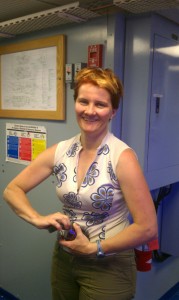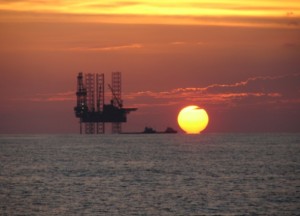Welcome Aboard!
Putting the “Fer” in FerrOCious
 I am glad you could join us on our journey to the Gulf of Mexico this summer. My name is Dr. Silke Severmann, and I am one of the three co-chief scientists on this cruise. The first tropical storm (named Don) is already lurking on the horizon, but that shall not deter us from our mission – although it might deflect us a little. We are a team of 11 scientists (including three students), two teachers, one science technician and 13 crew. Our ship is called the R/V Endeavor – R/V stands for Research Vessel – and the captain is Rhett McMunn. Back on dry land there will be children from schools in Florida, Louisiana and New Jersey following our progress. Hopefully you will learn about the science, our motivation for coming out to the Gulf during the hottest time of the year, and you’ll find out what it’s like to be a scientist at sea.
I am glad you could join us on our journey to the Gulf of Mexico this summer. My name is Dr. Silke Severmann, and I am one of the three co-chief scientists on this cruise. The first tropical storm (named Don) is already lurking on the horizon, but that shall not deter us from our mission – although it might deflect us a little. We are a team of 11 scientists (including three students), two teachers, one science technician and 13 crew. Our ship is called the R/V Endeavor – R/V stands for Research Vessel – and the captain is Rhett McMunn. Back on dry land there will be children from schools in Florida, Louisiana and New Jersey following our progress. Hopefully you will learn about the science, our motivation for coming out to the Gulf during the hottest time of the year, and you’ll find out what it’s like to be a scientist at sea.
Most people, when I tell them that I study the ocean, think I study the biology, because that’s the part of the ocean that seems most accessible, like when you’re scuba diving, or fishing, or whale watching, or rock pooling, or simply collecting shells on the beach. In fact, every branch of science is well represented in oceanography, including biology, chemistry, geology and physics – remember all the talk about the “loop current” in the Gulf last year? In physical oceanography we study how water moves around in the ocean, and what’s driving it, and although we don’t have a physical oceanographer on board this time, this will also be part of what we study. On this cruise, all the scientists on board are marine chemists, well, biogeochemists to be precise. We call ourselves that not because we couldn’t make up our mind which science discipline we like best, but because we recognize that the biology, geology and chemistry of the ocean are all connected, one affects the other. We make chemical measurements in the water and in the mud, but those measurements will also tell us about the biology, and this information is also very useful for geologists. How, I hear you ask? Well, it’s simple: the chemistry, like for example the amount of oxygen in the water, determines which organism live in the Gulf today. Some of the animals and plants will become part of the mud when they die and their skeletons sink to the bottom, and over many hundreds of thousands of years that mud will eventually turn into solid rock containing fossils. And when in a million years from now a geologist finds these rocks with the fossils, he or she will be able to tell what the chemistry of the Gulf was like and what life was like in the ocean at the time. Sounds an awful lot like forensics, doesn’t it? It kind of is, CSI Louisiana.
Now, you might have noticed that there’s a misspelling in the title of our blog − there’s one too many ‘r’s. That’s because the title is a word play on the name of our favorite element: iron. The Latin name for iron is ferrum, which is how the element got it’s elemental symbol Fe. Iron is a very important element for all organisms, that’s why Popeye ate so much spinach, it is very rich in iron (I am probably dating myself with this pop-culture reference). The same way that we need iron to make sure that our red blood cells can deliver oxygen to our body, the organism in the ocean need iron to thrive and survive. On this cruise our main goal is to find out where the organism get their iron from, how it is exchanged between the mud on the seafloor and the water above it. Most of the iron gets into the ocean through rivers, as sand or finer particles. In this form it is not very useful to most organism, because it sinks to the bottom before they can use it. But in the mud on the seafloor a number of chemical reactions happen, which turn the iron into its dissolved form, and it slowly leaks out of the mud back into the water above, where the organism can use it – in science lingo we say that the iron becomes “bioavailable”. The other two important ingredients for this process are organic carbon (mostly from dead plants, like the compost in your garden) and oxygen. That’s why the ‘C’ (for carbon) and ‘O’ (for oxygen) in the blog title are in capital letters.
So now you have already learned something about our three favorite elements: iron, carbon, and oxygen. There are many others though that we care about, some that might sound familiar, like manganese, others are more exotic, like neodymium or polonium. Check out our periodic table as we go along, and we’ll introduce some more of these elements to you and explain why we study them. You will also learn about the “dead zones” that form every summer in the Gulf, and have been getting bigger in recent years. As the name implies, they are not good places for fish to hang out, which is why they are very unpopular with fish and fishermen alike. Last but not least, the science for this project was conceived before the catastrophic explosion of the oil platform Horizon last year and the oil spill that followed. But obviously, the aftermath of the oil spill, as well as the record-breaking floods that occurred along the Mississippi delta this spring, will likely have a major effect on the chemistry and the biology of the  Gulf, and we’ll explain some of that as we go along.
Gulf, and we’ll explain some of that as we go along.
Also joining us on our venture will be two teachers, Cris and Wessal. Their job is to keep us honest and help us see the Gulf through your eyes – our lab goggles sometimes tend to get a little foggy, and we can only see what’s right in front of us. Cris and Wessal will help us to look up from the test tubes and sample bottles every now and then and keep our gaze on the wider horizon. On that note, gotta dash and check out the marvelous sun-set… Silke
Recent Posts
- The last line has been cast… August 19, 2011
- A Day in the Life of… August 18, 2011
- Land Ho! August 18, 2011
- A Proxy Approximation August 17, 2011
- Iron Man August 17, 2011
- What’s that smell? August 16, 2011
- What do you mean, “No purple gloves?” August 14, 2011
- Water Works August 13, 2011
- Pursuing Particles August 13, 2011
- A Plankton Life August 11, 2011


Recent Comments